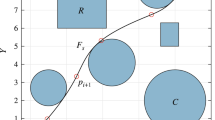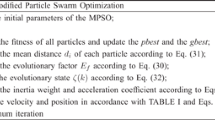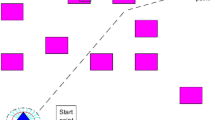Abstract
The planning problem for smooth paths for mobile robots has attracted particular research attention, but the strategy combining the heuristic intelligent optimization algorithm (e.g., particle swarm optimization) with smooth parameter curve (e.g., Bezier curve) for global yet smooth path planning for mobile robots has not been thoroughly discussed because of several difficulties such as the local trapping phenomenon in the searching process. In this paper, a novel multimodal delayed particle swarm optimization (MDPSO) algorithm is developed for the global smooth path planning for mobile robots. By evaluating the evolutionary factor in each iteration, the evolutionary state is classified by equal interval division for the swarm of the particles. Then, the velocity updating model would switch from one mode to another according to the evolutionary state. Furthermore, in order to reduce the occurrence of local trapping phenomenon and expand the search space in the searching process, the so-called multimodal delayed information (which is composed of the local and global delayed best particles selected randomly from the corresponding values in previous iterations) is added into the velocity updating model. A series of simulation experiments are implemented on a standard collection of benchmark functions. The experiment results verify that the comprehensive performance of the developed MDPSO algorithm is superior to other well-known PSO algorithms. Finally, the presented MDPSO algorithm is utilized in the global smooth path planning problem for mobile robots, which further confirms the advantages of the MDPSO algorithm over the traditional genetic algorithm (GA) investigated in previous studies. The multimodal delayed information in the MDPSO reduces the occurrence of local trapping phenomenon and the convergence rate is satisfied at the same time. Based on the testing results on a selection of benchmark functions, the MDPSO’s performance has been shown to be superior to other five well-known PSO algorithms. Successful application of the MDPSO for planning the global smooth path for mobile robots further confirms its excellent performance compared with the some typical existing algorithms.














Similar content being viewed by others
Explore related subjects
Discover the latest articles, news and stories from top researchers in related subjects.References
Andrews PS. An investigation into mutation operators for particle swarm optimization. Proceedings of IEEE Congress on Evolutionary Computation; 2006. p. 1044–1045.
Angeline PJ. Using selection to improve particle swarm optimization. Proceedings of IEEE Congress on Evolutionary Computation; 1998. p. 84–89.
Arana-Daniel N, Gallegos AA, Lopez-Franco C, Alanis AY. Smooth global and local path planning for mobile robot using particle swarm optimization, radial basis functions, splines and Bezier curves. Proceedings of IEEE Congress on Evolutionary Computation; 2014. p. 175–182.
Atyabi A, Powers DMW. Review of clasical and heuristic-based navigation and path planning approaches. International Journal of Advancements in Computing Technology. 2013;5:1–14.
Castillo O, Ttrujillo L, Melin P. Multiple objective genetic algorithms for path-planning optimization in autonomous mobile robots. Soft Comput. 2007;11:269–279.
Chen H, Liang J, Wang Z. Pinning controllability of autonomous Boolean control networks. Science China Information Sciences. 2016;59(7):070107. doi:10.1007/s11432-016-5579-8.
Chen X, Li Y. Smooth path planning of a mobile robot using stochastic particle swarm optimization. Proceedings of IEEE International Conference on Mechatronics and Automation; 2006. p. 1722–1727.
Chen YP, Peng WC, Jian MC. Particle swarm optimization with recombination and dynamic linkage discovery. IEEE Trans Syst Man Cybern B Cybern. 2007;37(6):1460–1470.
Clerc M, Kennedy J. The particle swarm: explosion, stability, and convergence in a multi-dimensional complex space. IEEE Trans Evol Comput. 2002;6(1):58–73.
Contreras-Cruz MA, Ayala-Ramirez V, Hernandez-Belnonte UH. Mobile robot path planning using artificial bee colony and evolutonary programming. Appl Soft Comput J. 2015;30:319–328.
Fetanat M, Haghzad S, Shouraki SB. Optimization of dynamic mobile robot path planning based on evolutionary methods. Proceedings of AI & Robotics (IRANOPEN 2015); 2015. p. 1–7.
Fong S, Deb S, Chaudhary A. A review of metaheuristics in robotics. Comput Electr Eng. 2015;43: 278–291.
Ho YJ, Liu JS. Collision-free curvatue-bounded smooth path planning using composite Bezier curve based on Voronoi diagram. Proceedings of IEEE International Symposium on Computational Intelligence in Robotics and Automation; 2009. p. 463–468.
Huang HC, Tsai CC. Global path planning for autonomous robot navigation using hybrid metaheuristi GA-PSO algorithm. Proceedings of SICE Annual Conference; 2011. p. 1338–1348.
Huang HC. FPGA-based parallel metaheuristic PSO algorithm and its application to global path planning for autonomous robot navigation. J Intell Rob Syst. 2014;76:475–488.
Jolly KG, Kumar RS, Vijayakumar R. A Bezier curve based path planning in a multi-agent robot soccer system without violating the acceleration limits. Rob Autom Syst. 2009;57(1):23–33.
Kennedy J, Eberhart R. Particel swarm optimization. Proceedings of IEEE International Conference on Neural Network; 1995. p. 1942–1948.
Li Q, Shen B, Liu Y, Alsaadi FE. Event-triggered H ∞ state estimation for discrete-time stochastic genetic regulatory networks with Markovian jumping parameters and time-varying delays. Neurocomputing. 2016;174:912–920.
Li Z, Yang C, Su C-Y., Ye W. Adaptive fuzzy-based motion generation and control of mobile under-actuated manipulators. Eng Appl Artif Intell. 2014;30:86–95.
Li Z, Yang C, Su C-Y., Deng J, Zhang W. Vision-based model predictive control for steering of a nonholonomic mobile robot. IEEE Trans Ind Electron. 2016;24(2):553–564.
Li W, Wei G, Han F, Liu Y. Weighted average consensus-based unscented Kalman filtering. IEEE Transactions on Cybernetics. 2016;46(2):558–567.
Liang JJ, Suganthan PN. 2005. Dynamic multi-swarm particle swarm optimizer with local search.
Liang JJ, Qin AK, Suganthan PN, Baskar S. Comprehensive learning particle swarm optimizer for global optimization of multimodal functions. IEEE Trans Evol Comput. 2006;10(3):281–295.
Liu D, Liu Y, Alsaadi FE. A new framework for output feedback controller design for a class of discrete-time stochastic nonlinear system with quantization and missing measurement. Int J Gen Syst. 2016;45(5): 517–531.
Liu S, Wei G, Song Y, Liu Y. Extended Kalman filtering for stochastic nonlinear systems with randomly occurring cyber attacks. Neurocomputing. 2016;207:708–716.
Liu S, Wei G, Song Y, Liu Y. Error-constrained reliable tracking control for discrete time-varying systems subject to quantization effects. Neurocomputing. 2016;174:897–905.
Liu Y, Liu W, Obaid MA, Abbas IA. Exponential stability of Markovian jumping Cohen-Grossberg neural networks with mixed mode-dependent time-delays. Neurocomputing. 2016;177:409–415.
Manikas TW, Ashenayi K, Wainwright RL. Genetic algorithms for autonomous robot navigation. IEEE Instrum Meas Mag. 2007;12(1):26–31.
Masehian E, Sedighizadeh D. Classic and heuristic approaches in robot motion planning-a chronological review. International Journal of Mechanical, Aerospace, Industrial, Mechatronic and Manufacturing Engineering. 2007; 1(5):228–233.
Mendes R, Kennedy J, Neves J. The fully informed particle swarm: simpler, maybe better. IEEE Trans Evol Comput. 2004;8(3):204–210.
Mo H, Xu L. Research of biogeography particle swarm optimization for robot path planning. Neurocomputing. 2015;148:91–99.
Mohajer B, Kiani K, Samiei E, Sharifi M. A new online random particles optimization algorithm for mobile robot path planning in dynamic environments. Math Probl Eng. 2013;2013:1–9.
Mohamed AZ, Lee SH, Hsu HY, Nath N. A faster path planner using accelerated particle swarm. Artificial Life & Robotics. 2012;17:233–240.
On S, Yazici A. A comparative study of smooth path planning for a mobile robot considering kinematic constraints. Proceedings of IEEE International Symposium on Innovations in Intelligent Systems and Applications; 2011. p. 565–569.
Pol RS, Murgugan M. A review on indoor human aware autonomous mobile robot navigation through a dynamic environment. Proceedings of IEEE International Conference on Industrial Instrumentation and Control. Pune; 2015. p. 1339–1344.
Qu H, Xing K, Alexander T. An improved genetic algorithm with co-evolutionary strategy for global path planning of multiple mobile robots. Neurocomputing. 2013;120:509–517.
Raja P, Pugazhenthi S. Optimal path planning of mobile robots: a review. International Journal of Physical Sciences. 2012;7(9):1314–1320.
Ratnaweera A, Halgamure SK, Watson HC. Self-organizing hierarchical particle swarm ooptimizer with time-varying acceleration coefficients. IEEE Transactions on Evolutionary Computation. 2004;8:240–255.
Shi Y, Eberhart R. A modified particle swarm optimizer. Proceedings of IEEE Internatonal Conference on Evolutionary Computation; 1998. p. 69–73.
Shi Y, Eberhart R. Parameter selection in particle swarm optimization. Proceedings of the 7th International Conference on Evolutionary Programming; 1998. p. 591–600.
Shi Y, Eberhart R. Empirical study of particle swarm optimization. Proceedings of IEEE Congress on Evolutionary Computation; 1999. p. 1945–1959.
Shu H, Zhang S, Shen B, Liu Y. Unknown input and state estimation for linear discrete-time systems with missing measurements and correlated noises. Int J Gen Syst. 2016;45(5):648–661.
Song B, Wang Z, Sheng L. A new genetic algorithm approach to smooth path planning for mobile robots. Assem Autom. 2016;36(2):138–145.
Song B, Tain G, Zhou F. A comparison study on path smoothing algorithms for laser robot navigatioed mobile robot path planning in intelligent space. Journal of Information and Computational Science. 2010;7(1):2943–2950.
Tang Y, Wang Z, Fang J. Parameters identification of unknown delayed genetic regulatory networks by a switching particle swarm optimization algorithm. Expert Syst Appl. 2011;38:2523– 2535.
Wen C, Cai Y, Liu Y, Wen C. A reduced-order approach to filtering for systems with linear equality constraints. Neurocomputing. 2016;193:219–226.
Xiao H, Li Z, Yang C, Zhang L, Yuan P, Ding L, Wang T. Robust stabilization of a wheeled mobile robot using model predictive control based on neuro-dynamics optimization. IEEE Trans Ind Electron. in press, doi:10.1109/TIE.2016.2606358.
Zeng N, Zhang H, Chen Y, Chen B, Liu Y. Path planning for intelligent robot based on switching local evolutonary PSO. Assem Autom. 2016;36(2):120–126.
Zeng N, Wang Z, Zhang H, Alsaadi FE. A novel switching delayed PSO algorithm for estimating unknown parameters of lateral flow immunoassay. Cognitive Computation. 2016;8:143–152.
Zhan Z, Zhang J, Li Y, Chung H. Adaptive particle swarm optimization. IEEE Trans Syst Man Cybern Part B Cybern. 2009;39(6):1362–1381.
Zhang J, Ma L, Liu Y. Passivity analysis for discrete-time neural networks with mixed time-delays and randomly occurring quantization effects. Neurocomputing. 2016;216:657–665.
Zhang W, Wang Z, Liu Y, Ding D, Alsaadi FE. Event-based state estimation for a class of complex networks with time-varying delays: a comparison principle approach. Phys Lett A. 2017;381(1):10–18.
Zhang WJ, Xie XF. DEPSO: Hybrid particle swarm with differential evolution operator. Proceedings of IEEE International Conference on Systtems, Man, and Cybernetics; 2004. p. 997–1006.
Zhou F, Song B, Tian G. Bezier curve based smooth path planning for mobile robot. Journal of Information and Computational Science. 2011;8(1):2441–2450.
Author information
Authors and Affiliations
Corresponding author
Ethics declarations
Conflict of Interests
The authors declare that they have no conflict of interest.
Informed Consent
All procedures followed were in accordance with the ethical standards of the responsible committee on human experimentation (institutional and national) and with the Helsinki Declaration of 1975, as revised in 2008 (5). Additional informed consent was obtained from all patients for which identifying information is included in this article.
Human and Animal Rights
This article does not contain any studies with human or animal subjects performed by the any of the authors.
Additional information
This work was supported in part by the Research Fund for the Taishan Scholar Project of Shandong Province of China and the Higher Educational Science and Technology Program of Shandong Province of China under Grant J14LN34.
Rights and permissions
About this article
Cite this article
Song, B., Wang, Z. & Zou, L. On Global Smooth Path Planning for Mobile Robots using a Novel Multimodal Delayed PSO Algorithm. Cogn Comput 9, 5–17 (2017). https://doi.org/10.1007/s12559-016-9442-4
Received:
Accepted:
Published:
Issue Date:
DOI: https://doi.org/10.1007/s12559-016-9442-4




